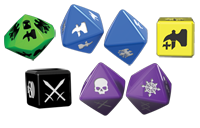In this diary, I provide an in-depth look at of the different types of dice, briefly discuss the core mechanic, and provide a downloadable PDF symbol reference. Check out the diary here .
I really enjoyed writing this diary, and am glad to be able to "pop the hood" on the game design a bit more and showcase one of the signature elements of the new edition -- the dice system.
UPDATE: I've added some additional sneak peek content to the end of the diary, providing a look at how dice pools are created, and have inclued an example of assembling a dice pool in the game.

 . I hope the game will be a success: I would like to see more designers seeing here a success and start using dice pools in their RPGs, as I think they make a more interactive story and help interpreting the results.
. I hope the game will be a success: I would like to see more designers seeing here a success and start using dice pools in their RPGs, as I think they make a more interactive story and help interpreting the results.
 ).
).


